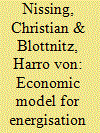| Srl | Item |
| 1 |
ID:
094931


|
|
|
|
|
| Publication |
2010.
|
| Summary/Abstract |
It is widely recognised that access to and supply of modern energy play a key role in poverty alleviation and sustainable development. The emerging concept of energisation seems to capture this idea, and if implemented in its full complexity it should have multiple beneficial effects. To demonstrate this, an economic model is developed for an urban developmental context, drawing on the theory of urban ecosystems and illustrating energy and waste production and consumption issues with current South African data sets. This new understanding of the concept of energisation is then integrated into a local government energy planning process, by means of a checklist for energy planners, covering 18 aspects that between them affect all 7 identifiable tiers of the energy service supply network. A 6-step structured approach is proposed for integrating sustainable energisation into the first four phases of the advanced local energy planning (ALEP) tool.
|
|
|
|
|
|
|
|
|
|
|
|
|
|
|
|
| 2 |
ID:
109406


|
|
|
|
|
| Publication |
2011.
|
| Summary/Abstract |
The necessity to reduce greenhouse gases emission produced by energy building consumptions and to cut the energy bill (mainly due to the use of fossil sources) leads to the employment of renewable energy sources in new planned scenarios. In particular, more and more often municipal energy and environmental plans pay great attention to the possibilities of employment of the solar technologies at urban scale.
Solar thermal and photovoltaic (PV) systems are, by far, the most suitable tools to be utilized in urban areas. Obviously, the proper adoption of such systems in buildings does call for the availability of calculation methods suitable to provide the actual level of exploitation of solar energy in urban layouts.
In this work, a procedure for evaluating the geographical energy potential of building roofs in urban areas is proposed; in particular, the amount of surface on the roof that could be used for the installation of systems able to capture solar radiation for the energy production is investigated. The proposed procedure is based on the use of the GIS technology and 3D cartography. The effectiveness of the proposed method is assessed by means of an application to the town of Palermo (Italy).
|
|
|
|
|
|
|
|
|
|
|
|
|
|
|
|
| 3 |
ID:
149938


|
|
|
|
|
| Summary/Abstract |
Nowadays, in Europe, the main challenge is not only the construction of new high performing buildings, but also the promotion of proper retrofit actions on existing buildings. In the on-going transition towards low carbon cities, tools to support local municipalities are fundamental.
|
|
|
|
|
|
|
|
|
|
|
|
|
|
|
|